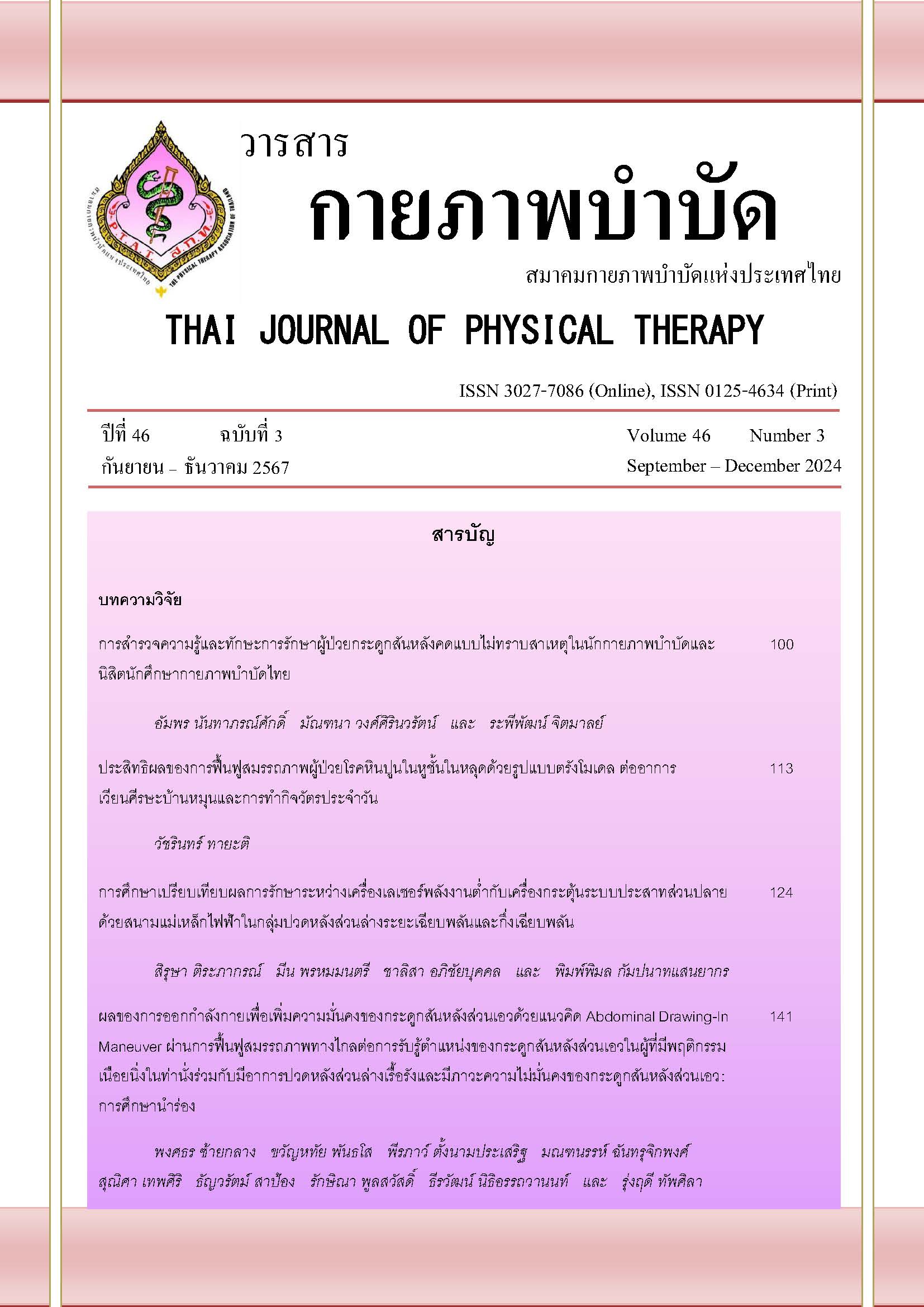ประสิทธิผลของการฟื้นฟูสมรรถภาพผู้ป่วยโรคหินปูนในหูชั้นในหลุดด้วยรูปแบบตรังโมเดล ต่ออาการเวียนศีรษะบ้านหมุนและการทำกิจวัตรประจำวัน
Main Article Content
บทคัดย่อ
ที่มาและความสำคัญ: โรคหินปูนในหูชั้นในหลุด (Benign paroxysmal positional vertigo :BPPV) เป็นสาเหตุที่พบบ่อยของอาการเวียนศีรษะ ส่งผลกระทบต่อการทำกิจวัตรประจำวัน การฟื้นฟูระบบเวสติบูลาร์ (vestibular rehabilitation: VRT) เป็นวิธีการรักษาที่มีประสิทธิภาพ โรงพยาบาลตรังได้พัฒนารูปแบบการรักษาที่เรียกว่าTrang model ซึ่งประกอบด้วยการตรวจประเมิน การทำ canalith repositioning procedure (CRP) เช่น Epley, Semont หรือ Gufoni maneuver ร่วมกับการทำ VRT อย่างเป็นระบบ พร้อมประเมินซ้ำและปรับแผนการรักษาเฉพาะบุคคล รวมถึงให้ความรู้และโปรแกรมการฝึกที่บ้านแก่ผู้ป่วย อย่างไรก็ตาม การศึกษาถึงประสิทธิผลของTrang modelในการรักษา BPPV โดยเฉพาะในกลุ่มประชากรไทยยังมีอยู่จำกัด จึงจำเป็นต้องมีการศึกษาผลลัพธ์ของการนำรูปแบบการรักษานี้ไปใช้ในบริบทของประเทศไทย
วัตถุประสงค์: เพื่อศึกษาประสิทธิผลของการฟื้นฟูสมรรถภาพผู้ป่วย BPPV ด้วยTrang model ต่อการหายของโรคและความสามารถในการทำกิจวัตรประจำวัน
วิธีการวิจัย: เป็นการศึกษาเชิงพรรณนาแบบย้อนหลัง ในผู้ป่วย BPPV 122 รายที่มารับการรักษาที่คลินิกลดเวียนศีรษะ รพ.ตรัง ระหว่าง ก.ย. 2565 - ส.ค. 2566 ประเมินผลจากคะแนน Visual Analog Scale (VAS), Dizziness Handicap Inventory (DHI) และผลการตรวจทางคลินิกได้แก่ Dix-Hallpike/Roll test, head impulse test (HIT) ก่อนและหลังรักษาด้วย Trang model วิเคราะห์ข้อมูลด้วยสถิติ Wilcoxon Signed Ranks Test และ McNemar test
ผลการวิจัย: กลุ่มตัวอย่างส่วนใหญ่เป็นหญิงร้อยละ77.90 และมีช่วงอายุ 61-80 ปี หลังรักษาพบคะแนน VAS ลดลงจาก 6.52 ± 1.61 เป็น 1.37 ± 0.91, คะแนน DHI เฉลี่ยลดลงจาก 48.95 เป็น 2.77 อย่างมีนัยสำคัญ (p < 0.01) ในผู้ป่วย BPPV ตามเกณฑ์คัดเข้า 122 ราย พบผู้ป่วยมี Dix-Hallpike/Roll test ผิดปกติร้อยละ 79.50 โดยทั้งหมดผลเป็นปกติหลังเข้ารับการรักษาด้วยTrang model และพบ head impulse test ผิดปกติก่อนการรักษาร้อยละ 81.10 โดยผลเป็นปกติหลังเข้ารับการรักษาด้วย Trang model เช่นเดียวกัน อย่างมีนัยสำคัญ (p<0.01) และ ร้อยละ 95.10 สามารถจำหน่ายได้หลังได้รับการรักษา 1-3 ครั้ง
สรุปผล: การฟื้นฟูสมรรถภาพผู้ป่วย BPPV ด้วย Trang model มีประสิทธิผลในการหายอาการของโรค และเพิ่มความสามารถในการทำกิจวัตรประจำวัน
Article Details

อนุญาตภายใต้เงื่อนไข Creative Commons Attribution-NonCommercial-NoDerivatives 4.0 International License.
เอกสารอ้างอิง
von Brevern M, Bertholon P, Brandt T, Fife T, Imai T, Nuti D, et al. Benign paroxysmal positional vertigo: diagnostic criteria. J Vestib Res. 2015;25(3-4):105-17.
Bhattacharyya N, Gubbels SP, Schwartz SR, Edlow JA, El-Kashlan H, Fife T, et al. Clinical practice guideline: benign paroxysmal positional vertigo (update). Otolaryngol Head Neck Surg. 2017;156(3_suppl):S1-S47.
Argaet EC, Bradshaw AP, Welgampola MS. Benign positional vertigo, its diagnosis, treatment and mimics. Clin Neurophysiol Pract. 2019;4:97-111.
Grill E, Strupp M, Müller M, Jahn K. Health services utilization of patients with vertigo in primary care: a retrospective cohort study. J Neurol. 2014;261(8):1492-8.
Bhattacharyya N, Baugh RF, Orvidas L, Barrs D, Bronston LJ, Cass S, et al. Clinical practice guideline: benign paroxysmal positional vertigo. Otolaryngol Head Neck Surg. 2008;139(5 Suppl 4):S47-81.
Hall CD, Herdman SJ, Whitney SL, Cass SP, Clendaniel RA, Fife TD, et al. Vestibular rehabilitation for peripheral vestibular hypofunction: an evidence-based clinical practice guideline. J Neurol Phys Ther. 2016;40(2):124-55.
Tayati W. BPPV assessment and treatment algorithm: Trang model [Internet]. Trang: Trang Hospital; 2021 [cited 2022 Apr 29]. Available from: http://www.tranghos.go.th/index.php/ 2019-06-26-09-38-44
Alghadir AH, Iqbal ZA, Whitney SL. An update on vestibular physical therapy. J Chin Med Assoc. 2013;76(1):1-8.
Emasithi A, Pakdee S, Isaradisaikul SK, Uthaikhup S. Translation and validation of the dizziness handicap inventory into Thai language. Otol Neurotol. 2022;43(2):e252-8.
Shaphe MA, Alshehri MM, Alajam RA, Beg RA, Hamdi NIA, Nanjan S, et al. Effectiveness of Epley-canalith repositioning procedure versus vestibular rehabilitation therapy in diabetic patients with posterior benign paroxysmal positional vertigo: a randomized trial. Life. 2023;13(5):1169.
Ribeiro KF, Oliveira BS, Freitas RV, Ferreira LM, Deshpande N, Guerra RO. Effectiveness of otolith repositioning maneuvers and vestibular rehabilitation exercises in elderly people with benign paroxysmal positional vertigo: a systematic review. Braz J Otorhinolaryngol. 2017;84(1):109-18.
Ribeiro KM, Freitas RV, Ferreira LM, Deshpande N, Guerra RO. Effects of balance vestibular rehabilitation therapy in elderly with benign paroxysmal positional vertigo: a randomized controlled trial. Disabil Rehabil. 2017;39(12):1198-206.
Ricci NA, Aratani MC, Caovilla HH, Cohen HS, Ganança FF. Effects of vestibular rehabilitation on balance control in older people with chronic dizziness: a randomized clinical trial. Am J Phys Med Rehabil. 2016;95(4):256-69.
Beynon GJ, Jani P, Baguley DM. A clinical evaluation of head impulse testing. Clin Otolaryngol Allied Sci. 1998;23(2):117-22.
von Brevern M, Radtke A, Lezius F, Feldmann M, Ziese T, Lempert T, et al. Epidemiology of benign paroxysmal positional vertigo: a population based study. J Neurol Neurosurg Psychiatry. 2007;78(7):710-5.
McDonnell MN, Hillier SL. Vestibular rehabilitation for unilateral peripheral vestibular dysfunction. Cochrane Database Syst Rev. 2015;1:CD005397.
Se To PL, Singh DKA, Whitney SL. Effects of customized vestibular rehabilitation plus canalith repositioning maneuver on gait and balance in adults with benign paroxysmal positional vertigo: a randomized controlled trial. J Vestib Res. 2022;32(1):79-86.
Kulcu DG, Yanik B, Boynukalin S, Kurtais Y. Efficacy of a home-based exercise program on benign paroxysmal positional vertigo compared with betahistine. J Otolaryngol Head Neck Surg. 2008;37(4):373-9.
Banerjee TK. Repositioning maneuvers in benign paroxysmal positional vertigo: how do we improve outcomes? Int J Res Med Sci. 2021;9(12):3764-8.
Ricci NA, Aratani MC, Doná F, Macedo C, Caovilla HH, Ganança FF. A systematic review about the effects of the vestibular rehabilitation in middle-age and older adults. Rev Bras Fisioter. 2010;14(5):361-71.


